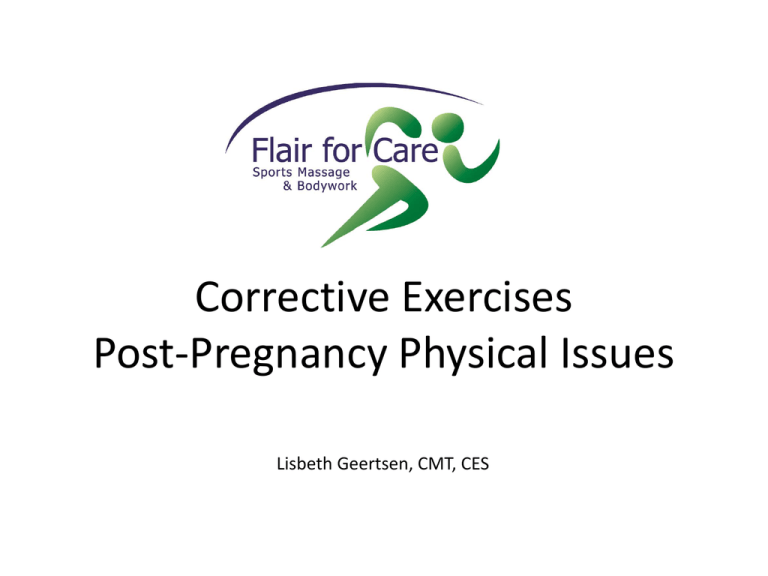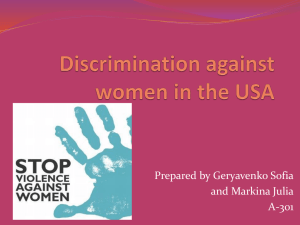Corrective Exercises Post-pregnancy
advertisement

Corrective Exercises Post-Pregnancy Physical Issues Lisbeth Geertsen, CMT, CES The Many Joys of Pregnancy 20-45 years Exercised before and during pregnancy Postural imbalances developed during pregnancy Prone to injury Started exercising after the birth of your first or second child Compensations patterns have developed The Many Joys of Pregnancy Physiological Changes during Pregnancy • Cardiovascular System • Respiratory System • Hormonal and Metabolic Changes • Musculoskeletal System The Many Joys of Pregnancy Hormonal and Metabolic Changes Hormones released to widen the birth canal by increasing ligamentous laxity. Relaxin Progesterone The Many Joys of Pregnancy Musculoskeletal System Average weight gain during pregnancy: 27.5 pounds (12.4kg). • The influence of this additional weight on the skeleton, coupled with the effects of relaxin and progesterone, increases ligamentous laxity. • Loosening of joints decreases joint stability in the hips, pelvis, and lumbosacral spine. The Many Joys of Pregnancy Baby grows and abdomen enlarges (abs stretch & diastasis recti), postural alignment is altered due to change in COG. Pelvis shifts anteriorly increasing the lordotic curve of the lower back Upper back posture becomes rounded as the back compensates for the increase in the lumbar lordosis. Shoulders become rounded and the head juts forward on the neck. The chest and shoulder are pulled forward and inward, increasing the kyphotic curve. Exaggerated Scurve of the spine (kyphotic lordotic postural alignment). The Many Joys of Pregnancy Musculoskeletal System The postural changes will eventually create muscular imbalances: Abdominal wall is stretched and weakened, and opposing muscles in the low back are forced to remain in a shortened position. Upper back muscles are elongated and weakened, and the chest and anterior shoulder muscles become chronically tight. The muscular activity in the posterior neck is also greatly increased as the head shifts forward. The Many Joys of Pregnancy Musculoskeletal System Laxity and weight gain can cause changes in the knees, feet, and ankles. The knees may be slightly hyperextended. Pregnancy can induce a drop in the arches and increase pronation of the foot, which may change the biomechanics of the lower kinetic chain. The Many Joys of Pregnancy Common conditions associated with pregnancy • Round ligament pain • Diastasis Recti • Pubic pain • Low-back pain • Leg cramps • Carpal Tunnel Syndrome • Varicose veins Muscular Imbalances related to Pregnancy • Lack of pelvic floor strength – which is ”the center of the universe” because it supports so many organs and bones (Dr. Linda Brubaker). • Internal scars an adhere to other parts of the body while healing, hampering muscle movement or causing pain years later (Debra Goodman, PT). • If a postpartum woman has weak core muscles or a large diastasis recti, running or other pounding exercises can be problematic. Hold off until you know you have stable core strength (Marianne Ryan). • Unresolved injuries during childbirth can show up later in life as pelvic floor disorder such as incontinence, and pelvic organ prolapse (Journal of the American Medical Association). Muscular Imbalances related to Pregnancy • Ask your doctor at the 4-6 week postpartum checkup to check strength of pelvic floor. • Exercising too hard too soon can lead to problems including pelvic pain. Women can exercise as they normally would during pregnancy and after their 4-6 week postpartum checkup as long as don’t have pain. • Risk factors: the more children the more like to have symptoms, and obesity. Muscular Imbalances related to Pregnancy • Postural changes during pregnancy creates certain “trained imbalances” between muscle groups than can lead to discomfort, pain, and in some cases, injury. • It’s important to counterbalance the natural tendency during pregnancy to become either ‘tight’ or ‘weak’ in specific areas, because the ‘trained imbalances’ will most likely sustain after pregnancy as well. • If muscle imbalances or poor flexibility has altered movement, then they may also have altered the way the core muscles react and stabilize. Muscular Imbalances related to Pregnancy • • Tight/overactive muscles: – Scapula protractors (pecs, ant. deltoid) & levator scapula – thoracolumbar area (latissimus dorsi) – hip flexors, ITB, piriformis, hamstrings & hip adductors – gastrocnemius & soleus Weak/underactive muscles: – Scapula retractors (rhomboids, middle/lower trap) – Abdominals (rectus abdominis, transverse abdominis, int/ext obliques) – lumbar paravertebral – pelvis floor, gluteus maximus , gluteus medius & quads • Instead of only focusing on each of these areas in isolation, incorporate functional movement exercises. • Conventional view: if tight calves => incorporate stretches for the calves. • Functional view: What movements are limited because of my tight calves? Ex.: Squatting => incorporate functional stretches and specific exercise progressions that can improve squatting. Identifying Muscular Imbalances Movement Patterns – – – – Squat Hurdle Step Lunge Shoulder mobilization – Active Straight Leg Raise – Rotational Identifying Muscular Imbalances • Posture – Poor posture due to weakened abdominal muscles • Muscle strains or misaligned bones – Annoying at first but can develop into debilitating disorder years or decades later. • Age – Many women in the US are older when having babies and in some cases spacing pregnancies closer together giving the body less time to recover. • Multiple birth – Increase in fertility treatment leads to more twin pregnancies which add to the physical strain on the women’s bodies. Focus on the CORE CORE CORE TRAINING Torso & Hip Stability & Coordination Your core is your power house, it should be from your core you generate force to move your extremities. FOCUS ON STABILITY! “Stability is the act of controlling force” (Athletic Body in Balance, 2010) Corrective Exercises • Abdominal Exercise – The rectus abdominis muscle is the focus in most traditional abdominal exercises e.g., crunches, but it’s even more important to strengthen the transverse abdominis , as it plays a key role in spinal stabillization. Also, its fibers are horizontally aligned, so when the belly expands, it can better adapt than rectus abdominis, and a stronger transverse abdominis may help prevent diastasis recti • Kegel Exercise – Push up and in to strengthen pelvic floor after pregnancy. Corrective Exercises • Pelvic Floor Exercise – The five layers of muscle and fascia attached to the bony ring of the pelvis are commonly referred to as the pelvic floor. They extend from the pubic bone to the tailbone and support the internal organs. They affect bladder, bowel, and sexual function. The weight gain and mechanical stress of the growing uterus creates a stretch weakness in the muscles of the pelvic floor. – Hormonal influences cause a softening of these tisues that further aggravates the weakness as does the birth process itself. – Maintaining the strength and integrity of these muscles during and after pregnancy is important to help prevent urinary stress incontinence, pelvis organ prolapse, pelvis pain from muscle spasm, and misalignment in the hip and sacroiliac joints. Corrective Exercises • The Better Balancer – To work core muscles, with the body in a line over the knee, hold the pelvis steady, breathe and circle the arms. • The Posture Promoter – For better alignment, stand with good posture and using your breath to engage your core muscles, lift arms overhead, which trains the body to move safely in everyday activity. Use theraband – anchor under feet and lift over head. • The Anti-Huncher. – To prevent rounded shoulders and hunching, sit on a balance ball and draw the shoulder blades down an back. Reference Beyond Baby Weight: What to Expect After You’re Expecting.









